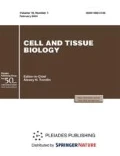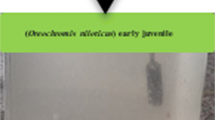Abstract
This paper is devoted to studying the effect of copper ions on the number and ratio of various subpopulations and functional properties of cells in the coelomic fluid of the starfish Asterias rubens. The experiments were carried out at the White Sea Biological Station named after N.A. Pertsov of the Faculty of Biology of Moscow State University. Starfish were exposed for 96 h to copper chloride (II) in concentrations of Cu2 + ions 0.78, 1.95, and 3.91 μM in aquariums. The number of coelomocytes was significantly increased in starfish kept in aquariums with a maximum concentration of copper ions. The distribution of cell subpopulations was also changed. The proportion of small cells increased from 9 to 15.5%, that of agranulocytes increased from 61 to 75%, and that of granulocytes decreased from 30 to 8.5%. Expression of stress-induced proteins 70 (HSC70/HSP70 ) that was determined by Western blot analysis increased in starfish in all experimental aquariums. The viability of the isolated coelomocytes estimated by the absorption of neutral red (NR) dye increased in starfish in experimental aquariums with copper ion concentrations of 0.78 and 1.95 μM as compared with the control. However, at the concentration of 3.91 μM, NR absorption drastically decreased. Taken together, it was shown that A. rubens responded to the exposure to copper (II) ions by increasing the number of circulating coelomocytes and enhancing the proportion of phagocytes subpopulation. It presumably may serve as a compensatory mechanism in response to the toxic effect of copper (II).


Similar content being viewed by others
REFERENCES
Barbaglio, A., Tricarico, S., Ribeiro, A., Ribeiro, C., Sugni, M., Di Benedetto, C., and Candia, D., The mechanically adaptive connective tissue of echinoderms: its potential for bio-innovation in applied technology and ecology, Mar. Environ. Res., 2012, vol. 76, p. 108.
Becker, J. and Craig, E.A., Heat-shock proteins as molecular chaperones, Eur. J. Biochem., 1994, vol. 219, p. 11.
Bradford, M.M., A rapid and sensitive method for the quantitation of microgram quantities of protein utilizing the principle of protein–dye binding, Anal. Biochem., 1976, vol. 72, p. 248.
Browne, C.L., Swan, J.B., Rankin, E.E., Calvert, H., Griffiths, S., and Tytell, M., Extracellular heat shock protein 70 has novel functional effects on sea urchin eggs and coelomocytes, J. Exp. Biol., 2007, vol. 210, p. 1275.
Chernogaeva, G.M., Обзор состояния и загрязнения окружающей среды в Российской Федерации за 2016 год (Overview of the State and Environmental Pollution in the Russian Federation for 2016), Moscow: Rosgidromet, 2017.
Coteur, G., Corriere, N., and Dubois, P., Environmental factors influencing the immune responses of the common European starfish (Asterias rubens), Fish Shellfish Immunol., 2004, vol. 16, p. 51.
Coteur, G., Gillan, D., Joly, G., Pernet, P., and Dubois, P., Field contamination of the starfish Asterias rubens by metals. Part 2: Effects on cellular immunity, Environ. Toxicol. Chem., 2003, vol. 22, p. 2145.
Deane, E.E., and Woo, N.Y.S., Cloning and characterization of the hsp70 multigene family from silver sea bream: modulated gene expression between warm and cold temperature acclimation, Biochem. Biophys. Res. Commun., 2005, vol. 330, p. 776.
Falugi, C., Aluigi, M.G., Chiantore, M.C., Privitera, D., Ramoino, P., Gatti, M.A., Fabrizi, A., Pinsino, A., and Matranga, V., Toxicity of metal oxide nanoparticles in immune cells of the sea urchin, Mar. Environ. Res., 2012, vol. 76, p. 114.
Fedyunin, V.A., Poromov, A.A., and Smurov, A.V., The effect of metals on the survival and vitality of starfish Asterias rubens, Toksikol.Vestn., 2018, vol. 151, no. 4, p. 29.
Franzellitti, S. and Fabbri, E., Differential HSP70 gene expression in the Mediterranean mussel exposed to various stressors, Biochem. Biophys. Res. Commun., 2005, vol. 336, p. 1157.
Guzik, T.J., Korbut, R., and Adamek-Guzik, T., Nitric oxide and superoxide in inflammation and immune regulation, J. Physiol. Pharmacol., 2003, vol. 54, p. 469.
Hauton, C., and Smith, V.J., In vitro cytotoxicity of crustacean immunostimulants for lobster (Homarus gammarus) granulocytes demonstrated using the neutral red uptake assay, Fish Shellfish Immunol., 2004, vol. 17, p. 65.
Korshenko, A.N., Seawater Quality according to Hydrochemical Indicators: A Yearbook, Moscow: Nauka, 2015.
Kozlova, A.B., Petukhova, O.A., and Pinaev, G.P., The analysis of cellular elements in coelomic fluid during early regeneration of the starfish Asterias rubens L., Tsitologiia, 2006, vol. 48 No 3, p. 175.
Kudryavtsev, I., D’yachkov, I., Mogilenko, D., Sukhachev, A., and Polevshchikov, A., The functional activity of fractions of coelomocytes of the starfish Asterias rubens Linnaeus, 1758, Russ. J. Mar. Biol., 2016, vol. 42, p. 158.
Order of the Federal Agency for Fisheries of January 18, 2010, no. 20 “On Approval of Water Quality Standards for Water Bodies of Fishery Importance, Including Standards of Maximum Permissible Concentrations of Harmful Substances in the Waters of Water Bodies of Fishery Importance,” 2010.
Poromov, A.A. and Smurov, A.V., Characterization of copepod Scottomyzon gibberum Scott population on Asterias rubens L. starfishes under different anthropogenic load conditions, Moscow Univ. Biol. Sci. Bull., 2014, vol. 69, no. 2, p. 74. Ronning, B.I., Echinoderm coelomocytes as a cellular model in toxicity testing and biomonitoring. https://www.duo.uio.no/bitstream/handle/10852/11837/ ronning.pdf?sequence=3&isAllowed=y.
Sharlaimova, N.S., Pinaev, G.P., and Petukhova, O.A., Cells of coelomic liquid and cells of different tissues of sea star Asterias rubens L. isolated from intact and post-traumatic animals: behavior and proliferation under cultivation in vitro, Tsitologiia, 2010, vol. 52, no. 4, p. 317.
Smith, L.C., Ghosh, J., Buckley, K.M., Clow, L.A., Dheilly, N.M., Haug, T., Henson, J.H., Li, C., Lun, C.M., Majeske, A.J., Matranga, V., Nair, S.V., Rast, J.P., Raftos, D.A., Roth, M., Sacchi, S., Schrankel, C.S., and Stensvag, K., Echinoderm immunity, in Invertebrate Immunity, New York: Landes Biosci. Spring Sci. + Business Media, 2010, p. 260.
Soto, M., Marigomez, I., and Cancio, I., Biological aspects of metal accumulation and storage, 2013. Accessed January 25, 2018. www.ehu.es/europeanclass2003/biological_aspects_of_metal_accu.htm.
Tsan, M.F., and Gao, B., Heat shock proteins and immune system, J. Leukocyte Biol., 2009, vol. 85, p. 905.
Funding
This work was supported by the Russian Foundation for Basic Research and the city of Sevastopol as part of scientific project no. 18-44-920007 r_a.
Author information
Authors and Affiliations
Corresponding author
Ethics declarations
Conflict of interest. The authors declare that they have no conflict of interest
Statement on the welfare of animals. Experiments with animals were carried out in accordance with the recommendations of E.A. Borisenko and Yu.K. Kissior on biomedical research using animals published at Novosibirsk State Agrarian University, Faculty of Biology and Technology, order no. 742 of 11/13/1984 approving the rules for conducting work using experimental animals; federal law no. 52-ФЗ “On the Animal World” with amendments and additions of April 24, 1995; and the interstate standard GOST (State Standard) 33044-2014 “Good Laboratory Practices” from 2015.
Additional information
Translated by I. Fridlyanskaya
Abbreviations: ROS—active oxygen species, LD50—median lethal dose, NR—neutral red, CF—coelomic fluid.
Rights and permissions
About this article
Cite this article
Fedyunin, V.A., Poromov, A.A. & Smurov, A.V. The Influence of Copper Ions on Cellular Elements of the Coelomic Fluid of Starfish Asterias Rubens L.. Cell Tiss. Biol. 14, 302–308 (2020). https://doi.org/10.1134/S1990519X20040021
Received:
Revised:
Accepted:
Published:
Issue Date:
DOI: https://doi.org/10.1134/S1990519X20040021




